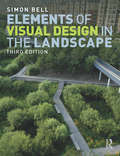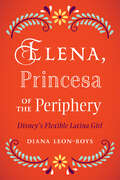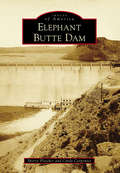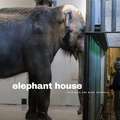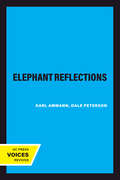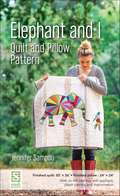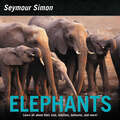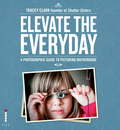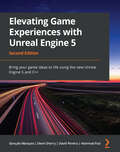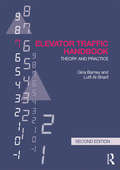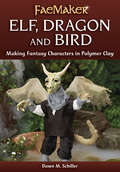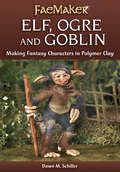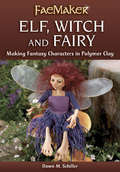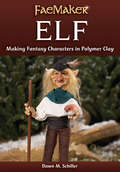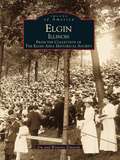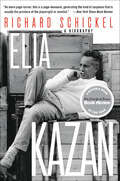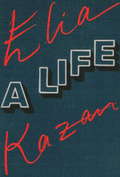- Table View
- List View
Elements of Visual Design in the Landscape
by Simon BellWhat makes a visually appealing landscape? How can the design and use of a landscape be harmonized? In this significantly revised and updated third edition of Simon Bell's seminal text, he further explores the answers to these questions by interrogating a range of design principles, applications and ideas. Written for students, instructors and professionals, the book unveils a visual design vocabulary for anyone involved with landscape aesthetics including landscape architects, architects, planners, urban designers, landscape managers, foresters, geographers and ecologists. Structured around key design terms, which are explained and illustrated using an extensive range of examples from around the world, including North America, Europe and Asia, this book enables you to describe, debate and design the visual landscape. It starts with basic elements, before moving onto variable design components, and then the ways these elements are organized into compositions, in order to demonstrate how landscapes are created and how meanings and patterns are perceived within them. This new full colour edition contains over 240 images; an updated introduction; examples from China, Vietnam and central Asia; a chapter on how to read and understand visual design elements in the landscape; a teaching model for instructors; and expanded appendix materials including a glossary, references and further reading.
Elena, Princesa of the Periphery: Disney’s Flexible Latina Girl (Latinidad: Transnational Cultures in the United States)
by Diana Leon-BoysIn the summer of 2016, Disney introduced its first Latina princess, Elena of Avalor. Princesa of the Periphery explores this Disney property using multiple case studies to understand its approach to girlhood and Latinidad. Following the circuit of culture model, author Diana Leon-Boys teases out moments of complex negotiations by Disney, producers, and audiences as they navigate Elena’s circulation. Case studies highlight how a flexible Latinidad is deployed through corporate materials, social media pages, theme park experiences, and the television series to create a princess who is both marginal to Disney’s normative vision of princesshood and central to Disney’s claims of diversification. This multi-layered analysis of Disney’s mediated Latina girlhood interrogates the complex relationship between the U.S.’s largest ethnic minority and a global conglomerate that stands in for the U.S. on the global stage.
Elephant Butte Dam
by Cindy Carpenter Sherry FletcherOn November 18, 1904, engineer B.M. Hall submitted his final report to the 12th National Irrigation Congress in El Paso, Texas. He concluded that the ideal location for a dam and reservoir would be a site in western New Mexico. A congressional act of February 25, 1905, authorized the construction of Elephant Butte Dam, the first civil engineering structure concerned with international allocation of water. Part of the Rio Grande Project, the dam and its reservoir would provide irrigation water for farmers along the Rio Grande in New Mexico, Texas, and Mexico. Today, Elephant Butte Dam is designated as a National Historical Engineer Landmark by the American Society of Civil Engineers (ASCE), the oldest national professional engineering society in the United States. The area is home to Elephant Butte Lake State Park, where camping, fishing, and water sports are enjoyed by both residents and tourists.
Elephant House (Animalibus)
by Nigel RothfelsIn Elephant House, photographer Dick Blau and historian Nigel Rothfels offer a thought-provoking study of the Oregon Zoo’s Asian Elephant Building and the daily routines of its residents—human and pachyderm alike. Without an agenda beyond a desire to build a deeper understanding of this enigmatic environment, Elephant House is the result of the authors’ unique creative collaboration and explores the relationships between captive elephants and their human caregivers.Blau’s evocative photographs are complex and challenging, while Rothfels’s text offers a scholarly and personal response to the questions that surround elephants and captivity. Elephant House does not take sides in the debate over zoos but focuses instead on the bonds of attentiveness between the animals and their keepers. Accompanied by a foreword from retired elephant keeper Mike Keele, Elephant House is a frank, fascinating look at the evolving world of elephant husbandry.
Elephant House (Animalibus: Of Animals and Cultures #7)
by Dick Blau Nigel RothfelsIn Elephant House, photographer Dick Blau and historian Nigel Rothfels offer a thought-provoking study of the Oregon Zoo’s Asian Elephant Building and the daily routines of its residents—human and pachyderm alike. Without an agenda beyond a desire to build a deeper understanding of this enigmatic environment, Elephant House is the result of the authors’ unique creative collaboration and explores the relationships between captive elephants and their human caregivers.Blau’s evocative photographs are complex and challenging, while Rothfels’s text offers a scholarly and personal response to the questions that surround elephants and captivity. Elephant House does not take sides in the debate over zoos but focuses instead on the bonds of attentiveness between the animals and their keepers. Accompanied by a foreword from retired elephant keeper Mike Keele, Elephant House is a frank, fascinating look at the evolving world of elephant husbandry.
Elephant Reflections
by Dale PetersonElephant Reflections brings award-winning wildlife photographer Karl Ammann's gorgeous images together with a revelatory text by writer Dale Peterson to illuminate one of nature's greatest and most original works of art: the elephant. The photographs move from the purely aesthetic to the informative, depicting animals who are at once enigmatic, individual, mysterious, elusive, and iconic. In riveting prose, Peterson introduces the work of field scientists in Africa and explains their recent astonishing discoveries. He then explores the natural history and conservation status of African elephants and discusses the politics of ivory. Elephant Reflections is a book that could change the way the world thinks about elephants while we still have some measure of control over their fate.
Elephant and I Quilt and Pillow Pattern
by Jennifer SampouStitch a scrap-friendly quilt and pillow inspired by Jennifer Sampou’s travels to Thailand. The best-selling fabric designer pairs paper-pieced and appliquéd motifs with a background of easy-to-sew strips. Gender-neutral and customizable, this artistically modern design is a definite showpiece. The full-size pattern includes complete instructions to make a quilt and a matching pillow. Proceeds from the sale of this pattern will be donated to Elephant Nature Park in Thailand, whose mission is to provide a rescue and rehabilitation center for elephants. Unique, gender-neutral design with full-size patterns Soft background with a splash of vibrant color Paper-pieced, appliquéd elephant and person motifs Wholesale minimum: 3 units.
Elephants
by Seymour SimonJoin award-winning science writer Seymour Simon as he investigates the many characteristics and behaviors of one of the world’s most beloved animals: the elephant! This nonfiction picture book is an excellent choice to share during homeschooling, in particular for children ages 6 to 8. It’s a fun way to learn to read and as a supplement for activity books for children.From their ancient relatives, woolly mammoths and mastodons, to their amazingly versatile trunks and strong ivory tusks, elephants are some of the most fascinating animals on Earth. They are remarkably intelligent, demonstrate self-awareness, and feel familiar emotions like compassion and grief.With clear, simple text and stunning full-color photographs, readers will learn all about the largest land animals in the world!Perfect for young scientists’ school reports, this book includes an author's note, a glossary, and an index and supports the Common Core State Standards.
Elevate The Everyday: A Photographic Guide To Picturing Motherhood
by Tracey ClarkTurn the everyday into the extraordinary with Elevate the Everyday, renowned photographer and blogger Tracey Clark's guide to documenting motherhood. Focusing on the beauty of ordinary moments, Tracey offers inspirational ideas that will jumpstart your photographic energies and enable you to see your children and yourself in a new way through the lens of your camera. Each day of a mother's life is full of photographic potential, and Elevate the Everyday gives you the tools to take moments and situations that might be easily overlooked and turn them into memorable and lasting photographs. With a host of creative ideas, technical tips, poignant stories of motherhood, and inspirational images that go far beyond traditional posed shots, Tracey shows you how to unlock your creativity and document your everyday life. Accessible and encouraging, this book is for everyone who wants to document the special moments in their lives, camera in hand.
Elevate the Masses: Alexander Gardner, Photography, and Democracy in Nineteenth-Century America
by Makeda BestAlexander Gardner is best known for his innovative photographic history of the Civil War. What is less known is the extent to which he was involved in the international workers’ rights movement. Tying Gardner’s photographic storytelling to his transatlantic reform activities, this book expands our understanding of Gardner’s career and the work of his studio in Washington, DC, by situating his photographic production within the era’s discourse on social and political reform.Drawing on previously unknown primary sources and original close readings, Makeda Best reveals how Gardner’s activism in Scotland and photography in the United States shared an ideological foundation. She reads his Photographic Sketch Book of the War as a politically motivated project, rooted in Gardner’s Chartist and Owenite beliefs, and illuminates how its treatment of slavery is primarily concerned with the harm that the institution posed to the United States’ reputation as a model democracy. Best shows how, in his portraiture, Gardner celebrated Northern labor communities and elevated white immigrant workers, despite the industrialization that degraded them. She concludes with a discussion of Gardner’s promotion of an American national infrastructure in which photographers and photography played an integral role.Original and compelling, this reconsideration of Gardner’s work expands the contribution of Civil War photography beyond the immediate narrative of the war to comprehend its relation to the vigorous international debates about democracy, industrialization, and the rights of citizens. Scholars working at the intersection of photography, cultural history, and social reform in the nineteenth century on both sides of the Atlantic will find Best’s work invaluable to their own research.
Elevate the Masses: Alexander Gardner, Photography, and Democracy in Nineteenth-Century America
by Makeda BestAlexander Gardner is best known for his innovative photographic history of the Civil War. What is less known is the extent to which he was involved in the international workers’ rights movement. Tying Gardner’s photographic storytelling to his transatlantic reform activities, this book expands our understanding of Gardner’s career and the work of his studio in Washington, DC, by situating his photographic production within the era’s discourse on social and political reform.Drawing on previously unknown primary sources and original close readings, Makeda Best reveals how Gardner’s activism in Scotland and photography in the United States shared an ideological foundation. She reads his Photographic Sketch Book of the War as a politically motivated project, rooted in Gardner’s Chartist and Owenite beliefs, and illuminates how its treatment of slavery is primarily concerned with the harm that the institution posed to the United States’ reputation as a model democracy. Best shows how, in his portraiture, Gardner celebrated Northern labor communities and elevated white immigrant workers, despite the industrialization that degraded them. She concludes with a discussion of Gardner’s promotion of an American national infrastructure in which photographers and photography played an integral role.Original and compelling, this reconsideration of Gardner’s work expands the contribution of Civil War photography beyond the immediate narrative of the war to comprehend its relation to the vigorous international debates about democracy, industrialization, and the rights of citizens. Scholars working at the intersection of photography, cultural history, and social reform in the nineteenth century on both sides of the Atlantic will find Best’s work invaluable to their own research.
Elevating Game Experiences with Unreal Engine 5: Bring your game ideas to life using the new Unreal Engine 5 and C++
by Devin Sherry David Pereira Hammad Fozi Gonçalo MarquesGet hands-on with game development tools and techniques to build a game project using the latest version of Unreal Engine and C++, two of the most widely used tools in the game industryKey FeaturesKickstart your career or develop a new hobby by learning game development with Unreal Engine 5 and C++Learn techniques to prototype and develop your own ideas with key images printed in colorReinforce your skills with project-based learning by building a series of games from scratchBook DescriptionImmerse yourself in the Unreal game projects with this book, written by four highly experienced industry professionals with many years of combined experience with Unreal Engine. Elevating Game Experiences with Unreal Engine 5 will walk you through the latest version of Unreal Engine by helping you get hands-on with the game creation projects. The book starts with an introduction to the Unreal Editor and key concepts such as actors, blueprints, animations, inheritance, and player input. You'll then move on to the first of three projects, building a dodgeball game, where you'll learn the concepts of line traces, collisions, projectiles, user interface, and sound effects. You’ll also discover how to combine these concepts to showcase your new skills. The second project, a side-scroller game, will help you implement concepts such as animation blending, enemy AI, spawning objects, and collectibles. And finally, you'll cover the key concepts in creating a multiplayer environment as you work on the third project, an FPS game. By the end of this Unreal Engine book, you'll have a broad understanding of how to use the tools that the game engine provides to start building your own games.What you will learnCreate a fully functional third-person character and enemiesImplement navigation with keyboard, mouse, and gamepadProgram logic and game mechanics with collision and particle effectsExplore AI for games with Blackboards and behavior treesBuild character animations with animation blueprints and montagesPolish your game with stunning visual and sound effectsExplore the fundamentals of game UI using a heads-up displayDiscover how to implement multiplayer in your gamesWho this book is forThis book is for game developers looking to get started with using Unreal Engine 5 for their game development projects. Anyone who has used Unreal Engine before and wants to consolidate, improve, and apply their skills will find this book useful. To better grasp the concepts explained in this book, prior knowledge of C++ basics such as variables, functions, classes, polymorphism, and pointers is required. For full compatibility with the IDE used in this book, a Windows system is recommended
Elevating Game Experiences with Unreal Engine 5: Bring your game ideas to life using the new Unreal Engine 5 and C++, 2nd Edition
by Goncalo Marques Devin Sherry David Pereira Hammad FoziGet hands-on with game development tools and techniques to build game project using the latest version of Unreal Engine and C++, two of the most widely used tools in the games industryKey FeaturesKickstart your career or develop a new hobby by learning game development with Unreal Engine 5 and C++Learn techniques to prototype and develop your own ideas with key images printed in colorReinforce your skills with project-based learning by building a series of games from scratchBook DescriptionImmerse yourself in the Unreal game projects with this book, written by four highly experienced industry professionals with many years of combined experience with Unreal Engine. Elevating Game Experiences with Unreal Engine 5 will walk you through the latest version of Unreal Engine by helping you get hands-on with the game creation projects. The book starts with an introduction to the Unreal Editor and key concepts such as actors, blueprints, animations, inheritance, and player input. You'll then move on to the first of three projects, building a dodgeball game, where you'll learn the concepts of line traces, collisions, projectiles, user interface, and sound effects. You'll also discover how to combine these concepts to showcase your new skills. The second project, a side-scroller game, will help you implement concepts such as animation blending, enemy AI, spawning objects, and collectibles. And finally, you'll cover the key concepts in creating a multiplayer environment as you work on the third project, an FPS game. By the end of this Unreal Engine book, you'll have a broad understanding of how to use the tools that the game engine provides to start building your own games.What you will learnCreate a fully functional third-person character and enemiesImplement navigation with keyboard, mouse, and gamepadProgram logic and game mechanics with collision and particle effectsExplore AI for games with Blackboards and behavior treesBuild character animations with animation blueprints and montagesPolish your game with stunning visual and sound effectsExplore the fundamentals of game UI using a heads-up displayDiscover how to implement multiplayer in your gamesWho this book is forThis book is for game developers looking to get started with using Unreal Engine 5 for their game development projects. Anyone who has used Unreal Engine before and wants to consolidate, improve, and apply their skills will find this book useful. To better grasp the concepts explained in this book, prior knowledge of C++ basics such as variables, functions, classes, polymorphism, and pointers is required. For full compatibility with the IDE used in this book, a Windows system is recommended
Elevator Traffic Handbook: Theory and Practice
by Gina Barney Lutfi Al-SharifThis second edition of this well-respected book covers all aspects of the traffic design and control of vertical transportation systems in buildings, making it an essential reference for vertical transportation engineers, other members of the design team, and researchers. The book introduces the basic principles of circulation, outlines traffic design methods and examines and analyses traffic control using worked examples and case studies to illustrate key points. The latest analysis techniques are set out, and the book is up-to-date with current technology. A unique and well-established book, this much-needed new edition features extensive updates to technology and practice, drawing on the latest international research.
Eleven Exercises in the Art of Architectural Drawing: Slow Food for the Architect's Imagination
by Marco FrascariThis book deals with the critical nature and crucial role of architectural drawings. A manual which is essentially not a manual; it is an elucidation of an elegant manner for practising architecture. Organized around eleven exercises, the book does not emphasize speed, nor incorporate many timesaving tricks typical of drawing books, but rather proposes a slow, meditative process for construing drawings and for drawing constructing thoughts. This is an indispensable reference text and an effective textbook for students seeking to advance their appreciation of the nature and exercise of architectural drawings.
Elf, Dragon and Bird: Making Fantasy Characters in Polymer Clay (FaeMaker)
by Dawn M. SchillerThis fun book shows readers how to make standalone fantasy character figures with polymer clay. Readers will learn about materials, special precautions and quick, simple techniques; then they will get 3 step-by-step demonstrations including an Elf, Dragon and Bird. Each demonstration shows how to make accurate figures, from beginning supports to sculpting the head (including eyes, chins, noses, brows, lips, cheeks, mouths, ears, makeup and hair) bodies, baking and costuming.
Elf, Ogre and Goblin: Making Fantasy Characters in Polymer Clay (FaeMaker)
by Dawn M. SchillerThis fun book shows readers how to make standalone fantasy character figures with polymer clay. Readers will learn about materials, special precautions and quick, simple techniques; then they will get 3 step-by-step demonstrations including an Elf, Ogre and Goblin. Each demonstration shows how to make accurate figures, from beginning supports to sculpting the head (including eyes, chins, noses, brows, lips, cheeks, mouths, ears, makeup and hair) bodies, baking and costuming.
Elf, Troll and Satyr: Making Fantasy Characters in Polymer Clay (FaeMaker)
by Dawn M. SchillerThis fun book shows readers how to make standalone fantasy character figures with polymer clay. Readers will learn about materials, special precautions and quick, simple techniques; then they will get 3 step-by-step demonstrations including an Elf, Troll and Satyr. Each demonstration shows how to make accurate figures, from beginning supports to sculpting the head (including eyes, chins, noses, brows, lips, cheeks, mouths, ears, makeup and hair) bodies, baking and costuming.
Elf, Witch and Fairy: Making Fantasy Characters in Polymer Clay (FaeMaker)
by Dawn M. SchillerThis fun book shows readers how to make standalone fantasy character figures with polymer clay. Readers will learn about materials, special precautions and quick, simple techniques; then they will get 3 step-by-step demonstrations including an Elf, Witch and Fairy. Each demonstration shows how to make accurate figures, from beginning supports to sculpting the head (including eyes, chins, noses, brows, lips, cheeks, mouths, ears, makeup and hair) bodies, baking and costuming.
Elf: Making Fantasy Characters in Polymer Clay (FaeMaker)
by Dawn M. SchillerThis fun book shows readers how to make standalone fantasy character figures with polymer clay. Readers will learn about materials, special precautions and quick, simple techniques; then they will get 1 step-by-step demonstration. The demonstration shows how to make an accurate Elf figure, from beginning supports to sculpting the head (including eyes, chin, nose, brows, lips, cheeks, mouth, ears, makeup and hair) body, baking and costuming.
Elgin, Illinois: From the Collection of the Elgin Area Historical Society
by Jim Edwards Wynette EdwardsElgin was named by a city founder, James T. Gifford, after his favorite hymn. The city shares its name with 20 cities in 15 states and 8 countries. Elgin is situated on the banks of the Fox River, 35 milesnorthwest of Chicago, the city with which Elgin had thriving business exchanges in agricultural and industrial goods. The city's world-wide fame, for the most part, has come from its watch factory and Mr. Gail Borden's milk company. Pianos, shoes, books, and even chewing gum were also manufactured in Elgin and sold internationally. This exciting new study of a major Midwestern city is chock-full of images, many of which have never before been published. Featured in Elgin, Illinois is information about the Elgin National Watch Company, early circus and carnival attractions, as well as rip-roaring national road races. Highlighted in one chapter is Elgin's part in helping to win World War Iat home, complete with original photographs from the front in Europe. This lively and historical look at Elgin from the 1800s to the 1930s is interwoven with national and international trends and events.
Elgin, Illinois: Wish You Were Here
by William E. BennettElgin, Illinois, was founded in 1835. However, the community truly came into its own at the end of the Civil War, when the Elgin National Watch Company moved there and took the city name as its own. The name Elgin became synonymous with quality for over 100 years. Elgin, Illinois: "Wish You Were Here" tells the story of the town of Elgin during the 20th century, featuring vintage postcards of that period.Special events of historic interest include the tornado of 1920, and the Elgin Road Races, which gained national fame for a brief time around the World War I era. More than 200 pictures, culled from the collection of the Elgin Area Historical Society, and colorful narratives tell of the accomplishments by those first few generations who lived and died in the community.
Elia Kazan: A Biography
by Richard Schickel“No mere page-turner, this is a page-devourer, generating the kind of suspense that is usually the province of the playwright or novelist.” —The New York Times Book ReviewFew figures in film and theater history tower like Elia Kazan. Born in 1909 to Greek parents in Istanbul, Turkey, he arrived in America with incomparable vision and drive, and by the 1950s he was the most important and influential director in the nation, simultaneously dominating both theater and film. His productions of A Streetcar Named Desire and Death of a Salesman reshaped the values of the stage. His films—most notably On the Waterfront—brought a new realism and a new intensity of performance to the movies. Kazan’s career spanned times of enormous change in his adopted country, and his work affiliated him with many of America’s great artistic moments and figures, from New York City’s Group Theatre of the 1930s to the rebellious forefront of 1950s Hollywood; from Katharine Hepburn and Spencer Tracy to Marlon Brando and James Dean.Ebullient and secretive, bold and self-doubting, beloved yet reviled for “naming names” before the House Un-American Activities Committee, Kazan was an individual as complex and fascinating as any he directed. Noted film historian and critic Richard Schickel illuminates much more than a single astonishing life and life’s work: He pays discerning tribute to the power of theater and film, and casts a new light on six crucial decades of American history.Includes photographsA New York Times Notable Book“Magnificent.” —The Washington Post“Unsparingly thorough.” —Publishers Weekly“Remarkably insightful.” —Martin Scorsese“Vividly conveys the director’s potent personality: his exuberance, relentless work ethic, and frank assessments of the fleeting nature of fame.” —Booklist (starred review)
Elia Kazan: A Life
by Elia Kazan"This is the best autobiography I've read by a prominent American in I don't know how many years. It is endlessly absorbing and I believe this is because it concerns a man who is looking to find a coherent philosophy that will be tough enough to contain all that is ugly in his person and his experience, yet shall prove sufficiently compassionate to give honest judgment on himself and others. Somehow, the author brings this off. Elia Kazan: A Life has that candor of confession which is possible only when the deepest wounds have healed and honesty can achieve what honesty so rarely arrives at--a rich and hearty flavor. By such means, a famous director has written a book that offers the kind of human wealth we find in a major novel." --Norman Mailer. In this amazing autobiography, Kazan at seventy-eight brings to the undiluted telling of his story--and revelation of himself--all the passion, vitality, and truth, the almost outrageous honesty, that have made him so formidable a stage director (A Streetcar Named Desire, Death of a Salesman, All My Sons, Cat on a Hot Tin Roof, Tea and Sympathy), film director (On the Waterfront, East of Eden, Gentleman's Agreement, Splendor in the Grass, Baby Doll, The Last Tycoon, A Face in the Crowd), and novelist (the number-one best-seller The Arrangement.) Kazan gives us his sense of himself as an outsider (a Greek rug merchant's son born in Turkey, an immigrant's son raised in New York and educated at Williams College). He takes us into the almost accidental sojourn at the Yale Drama School that triggered his commitment to theatre, and his edgy, exciting apprenticeship with the new and astonishing Group Theatre, as stagehand and stage manager--and as actor (Waiting for Lefty, Golden Boy) ... his first nervous and then successful attempts at directing for theatre and movies (The Skin of Our Teeth, A Tree Grows in Brooklyn) ... his return to New York to co-found the Actors Studio (and his long and ambivalent relationship with Lee Strasberg) ... his emergence as premier director on both coasts. With his director's eye for the telling scene, Kazan shares the joys and complications of production, his unique insights on acting, directing, and producing. He makes us feel the close presence of the actors, producers, and writers he's worked with--James Dean, Marlon Brando, Tennessee Williams, Vivien Leigh, Tallulah Bankhead, Sam Spiegel, Darryl Zanuck, Harold Clurman, Arthur Miller, Budd Schulberg, James Baldwin, Clifford Odets, and John Steinbeck among them. He gives us a frank and affectionate portrait of Marilyn Monroe. He talks with startling candor about himself as husband and--in the years where he obsessively sought adventure outside marriage--as lover. For the first time, he discusses his Communist Party years and his wrenching decision in 1952 to be a cooperative witness before HUAC. He writes about his birth as a writer. The pace and organic drama of his narrative, his grasp of the life and politics of Broadway and Hollywood, the keenness with which he observes the men and women and worlds around him, and, above all, the honest with which he pursues and captures his own essence, make this one of the most fascinating autobiographies of our time.
Elinor Fry: A Legacy of Dance in Richmond
by Paul N. HerbertIn Richmond, no other name is more synonymous with dance than Elinor Fry. Helen Keller, Bill "Bojangles" Robinson and author Tom Wolfe were just some of the people with whom Fry connected in five decades of dance. From 1920 to 1970, Fry was involved, often accompanied by her beloved students, in nearly every major public event in the River City. Performing in an array of venues and photographed twice by "National Geographic," Fry was a blend of creativity and business savvy and a wonderful role model for thousands of children who learned dance in her studio. Join author and historian Paul Herbert as he celebrates Elinor Fry's spirit and exceptional achievements in the world of dance in Richmond.
